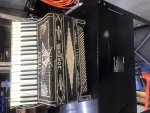Good Evening All,
I recently acquired a Soprani Napoli 120 bass accordion, that I’m working on restoring in my spare time. I’m guessing it was made in the 30’s. I’m looking for ideas on repairing the 3” of trim/pinstripe that’s missing on the front above the Soprani logo and bottom corner? It almost looks like guitar binding? It’s not painted, it’s raised. My thought was get a ivory piece of guitar binding and gold flake automotive pin stripe tape to go down the center of the binding. Any other thoughts or suggestions? I know it won’t be perfect and it will be impossible to match. Or is there a way to remove the whole piece from top to bottom with out damaging the celluloid underneath? and I’ll pinstripe where it was. I just like the look of a complete strip with out the middle missing. Thanks


I recently acquired a Soprani Napoli 120 bass accordion, that I’m working on restoring in my spare time. I’m guessing it was made in the 30’s. I’m looking for ideas on repairing the 3” of trim/pinstripe that’s missing on the front above the Soprani logo and bottom corner? It almost looks like guitar binding? It’s not painted, it’s raised. My thought was get a ivory piece of guitar binding and gold flake automotive pin stripe tape to go down the center of the binding. Any other thoughts or suggestions? I know it won’t be perfect and it will be impossible to match. Or is there a way to remove the whole piece from top to bottom with out damaging the celluloid underneath? and I’ll pinstripe where it was. I just like the look of a complete strip with out the middle missing. Thanks



